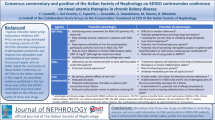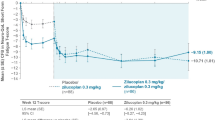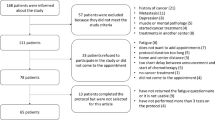Abstract
Fatigue is a common complaint in long termdialysis patients that may influence theirquality of life. The present study was carriedout in order to evaluate the prevalence andcourse of fatigue in a group of chronic PDpatients and to find the possible factor(s)related to its development. We retrospectivelyreviewed 100 charts of the patients previouslyon PD. The presence or absence of fatigue inthe 1st and last clinic visits and the 1st and2nd changes in fatigue state were studiedaccording to the monthly clinical records ofthe primary nurses. Data regarding dialysatevolume, urine volume, weekly erythropoietin(EPO) dose, hemoglobin, hematocrit, blood urea,serum creatinine, residual renal creatinine andurea clearances, dialysate to peritonealcreatinine ratio (D/P Cr), total weekly Kt/Vand total creatinine clearance/l.73 m2 bodysurface area (TCrCl) were collected. Fifty-fivepatients were male and 45 female. The mean ageat the 1st clinic visit was 61.3 ± 16 years.At the 1st visit 55 patients had fatigue and 45did not. In 32 of the 55 patients fatiguedisappeared after a mean duration of 7.9 ± 8.4months and in 31 of the 45 patients fatigueappeared after a mean duration of 8 ± 6.8months. So at the last visit the frequency offatigue increased significantly from 55% to67% (p < 0.001). In patients with fatigue themean age and female percentage were higher(64.2 ± 14.1 vs 57.8 ± 17.6, p = 0.05 and 1.2vs 0.5, p < 0.05 respectively), mean hemoglobinconcentration was lower (104.4 ± 14.7 vs110.6 ± 14.2 g/L, p < 0.04) and mean EPO dosewas higher (6379.6 ± 7142 vs 3395.4 ± 4337.8units/week, p < 0.02) at the 1st clinic visit.EPO dose was also higher in patients withfatigue at the last visit (8253.7 ± 10317.3units/wk vs 4736.4 ± 5432.5, p < 0.03). Nocorrelation was found between dialysis adequacyaccording to either weekly Kt/V or TCrCl andnutritional state according to nPCR andfrequency of fatigue. We conclude that fatigueis a common symptom in PD patients and it'sprevalence increases over time. Anemia seemsto be the most important factor associated withfatigue. Dialysis adequacy and nutritionalstate did not show any correlation with thefrequency of fatigue in our study.
Similar content being viewed by others
References
Wessely S, Chalder T, Hirsch S et al. The prevalence and morbidity of chronic fatigue and chronic fatigue syndrome: A prospective primary care study. Am J Public Health 1997; 87(9): 1449–1455.
Bates DW, Schmitt W, Buchwald D et al. Prevalence of fatigue and chronic fatigue syndrome in a primary care practice. Arch Intern Med 1993; 153(24): 2759–2765.
Kroenke K, Arrington ME, Mangelsdorff AD. The prevalence of symptoms in medical outpatients and adequacy of therapy. Arch Intern Med 1990; 150(8): 1685–1689.
Fuher R, Wessely S. The epidemiology of fatigue and depression: A French primary-care study. Psychol Med 1995; 25(5): 895–905.
Walker EA, Katon WJ, Jemelka RP. Psychiatric disorders and medical care utilization among people in the general population who report fatigue. J Gen Intern Med 1993; 8(8): 436–440.
Lawrie SM, Manders DN, Gedes JR, Pelosi AJ. A populationbased incidence of chronic fatigue. Psychol Med 1997; 27(3): 343–353.
Kroenke K, Wood DR, Mangelsdorff AD et al. Chronic fatigue in primary care. Prevalence, patient characteristics and outcome. JAMA 1988; 260(7): 929–934.
Wessely S, Chalder T, Hirsch S et al. Postinfectious fatigue: Prospective cohort study in primary care. Lancet 1995; 345(8961): 1333–1338.
Chang WK, Hung KW, Huang JW et al. Chronic fatigue in long-term peritoneal dialysis patients. Am J Nephrol 2001; 21(6): 479–485.
Cardenas DD, Kutner NG. The problem of fatigue in dialysis patients. Nephron 1982; 30(4): 336–340.
Sklar A, Newman N, Scott R et al. Identification of factors responsible for postdialysis fatigue. Am J Kidney Dis 1999; 34(3): 464–470.
Sakurauchi Y, Matsumoto Y, Shinzato T et al. Effects of L-carnitine supplementation on muscular symptoms in hemodialyzed patients. Am J Kidney Dis 1998; 32(2): 258–264.
Brass EP, Adler S, Sietsema KE et al. Intravenous L-carnitine increases plasma carnitine, reduces fatigue, and may preserve exercise capacity in hemodialysis patients. Am J Kidney Dis 2001; 37(5): 1018–1028.
Blake PG, Balaskas EV, Izatt S, Oreopoulos DG. Is total creatinine clearance a good predictor of clinical outcome in continuous ambulatory peritoneal dialysis? Preit Dialysis Int 1992; 12(4): 353–358.
Klang B, Clyne N.Well being and functional ability in uremic patients before and after having started dialysis treatment. Scand J Caring Sci 1997; 11(3): 159–166.
Clyne N, Jogestrand T, Lins LE, Pehrsson SK. Progressive decline in renal function induces a gradual decrease in total hemoglobin and exercise capacity. Nephron 1994; 67(3): 322–326.
Toy P, Feiner J, Viele MK et al. Fatigue during acute isovolemic anemia in healthy, resting humans. Transfusion 2000; 40(4): 457–460.
Moreno F, Aracil FJ, Perez R, Valderrabano F. Controlled study on the improvement of quality of life in elderly hemodialysis patients after correcting end-stage renal disease-related anemia with erythropoietin. Am J Kidney Dis 1996; 27(4): 548–556.
Thompson CH, Kemp GJ, Taylor DJ et al. Effect of chronic uremia in skeletal muscle metabolism in man. Nephrol Dial Transplant 1993; 8(3): 218–222.
Blake PG, Sombolos K, Abraham G et al. Lack of correlation between urea kinetic indices and clinical outcome in CAPD patients. Kidney Int 1991; 39(4): 700–706.
Cushman KE. Symptom management: A comprehensive approach to increasing nutritional status in cancer patient. Cushman KE Semin Oncol Nurs 1986; 2(1): 30–35.
Grant M, Kravits K. Symptoms and their impact on nutrition. Semin Oncol Nurs 2000; 16(2): 113–121.
Author information
Authors and Affiliations
Rights and permissions
About this article
Cite this article
Ossareh, S., Roozbeh, J., Krishnan, M. et al. Fatigue in chronic peritoneal dialysis patients. Int Urol Nephrol 35, 535–541 (2003). https://doi.org/10.1023/B:UROL.0000025610.67447.b9
Issue Date:
DOI: https://doi.org/10.1023/B:UROL.0000025610.67447.b9




